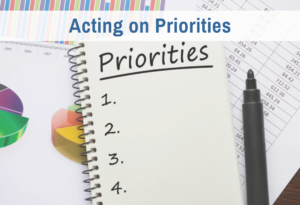In recent years, I’ve incorporated ideas from The Twelve Week Year (by Brian Moran) into my routines, and found them very helpful.
My top takeaway from this book is the idea of setting quarterly goals rather than annual or monthly goals. When you set goals you intend to accomplish in 12 weeks, every week matters. It’s easier to stay focused on them and get them done. The 13th week of the quarter is used for reflection and planning.
The second crucial takeaway from this book is the idea of setting “leading” indicators.
When you set a goal, you also need to set metrics to tell whether you are on track for completing it. For example, I’m writing a book, and a standard metric would be pages written in a day, or chapters written in a month.
The problem with most metrics is that they are “lagging” indicators. They are backward looking. They tell you what happened in the past. If you don’t get the number of pages written in the time allotted, you know you failed. The poor performance on the metric just makes that explicit.
What is needed to keep on track is leading indicators. These are metrics that predict whether or not you will succeed.
So, for example, for working on the book, that might be hours spent during the week writing. If all that is needed to finish the book is to put in sufficient hours, then hours will predict your eventual success on the book.
If you get low scores on leading indicators, you know you haven’t been putting in the effort where it needs to go.
On the other hand, if you get high scores on your leading indicators, but you don’t actually accomplish the goals on schedule, it turns out that you don’t actually know what exactly is needed to achieve the goal.
For example, I learned that I need about twice as much time writing during the week to make the kind of progress on the book that I want to make (About 20 hours a week rather than 12.)
The trick is to figure out the leading indicators that in fact predict success. After having used the “12-week year” method for about six months, I can tell you that it’s not so easy. Time on task is not always a good leading indicator!
What’s helped me to set “leading indicators” better is the ideas from Small Move, Big Change by Caroline Arnold. Her book is on habit change. Her thesis is that you should change habits by finding the small action to focus on that will make it easy to change a whole pattern. So, for example, to get more organized, she set up a routine of always putting the keys in exactly one place. That anchored many other small actions, making her whole day smoother. By focusing on crucial small actions, she was able to make significant changes in her routines.
I applied this idea to my productivity. My “lagging” indicator for productivity is the number of “pomodoros” (concentrated 25-minute segments) that I work each week.
Sometimes I do well, sometimes not so much. Looking it over, I decided that the biggest problem was that when I was tired or having trouble, my breaks would drag on too long. I would slip down a slope of reading “one more page” in the newspaper, or watching “one more show” on TV, or reading “one more chapter” in a novel.
Since I am also trying to root out the duty premise, forcing myself to go back to work was not an option. At these moments, I was not willing to end the break. But I needed some way to change the dynamic of the break.
I came up with a simple change. Before I read any page of the newspaper, or watch any show, or read any chapter in a novel, I first read at least one paragraph of Ayn Rand. Then when I get to the end of the page or chapter or program, I need to read another paragraph of Ayn Rand to continue.
Reading Ayn Rand is also a break — but a more intellectually stimulating one.
If I’m tired, one paragraph is about all I’m good for, and I usually realize I need a nap, not a pleasure break. That’s a much more effective use of time.
Usually I read a lot more than one paragraph of Ayn Rand. Sometimes that becomes my entire break, and I go back to work. Sometimes I take the pleasure break when I finish, but it has a different quality. I’m more energized for it, and it’s always shorter. I never get into the vicious cycle of “not feeling like” getting back to work.
Now, my leading indicator for productivity is: do I read at least one paragraph of Ayn Rand before any of these three “break” activities? This turns out to be an excellent predictor of my actual work.
This particular intervention works for me, but it is idiosyncratic. It’s just an example a small concrete action I took to take to change a pattern.
The moral of the story is: if you are not achieving a goal on the time scale you have set, trace back to find the pattern of failure. See if you can find some small action to break that pattern. Then turn that new action into a metric — a leading indicator of whether you will achieve your goal on schedule.








0 Comments